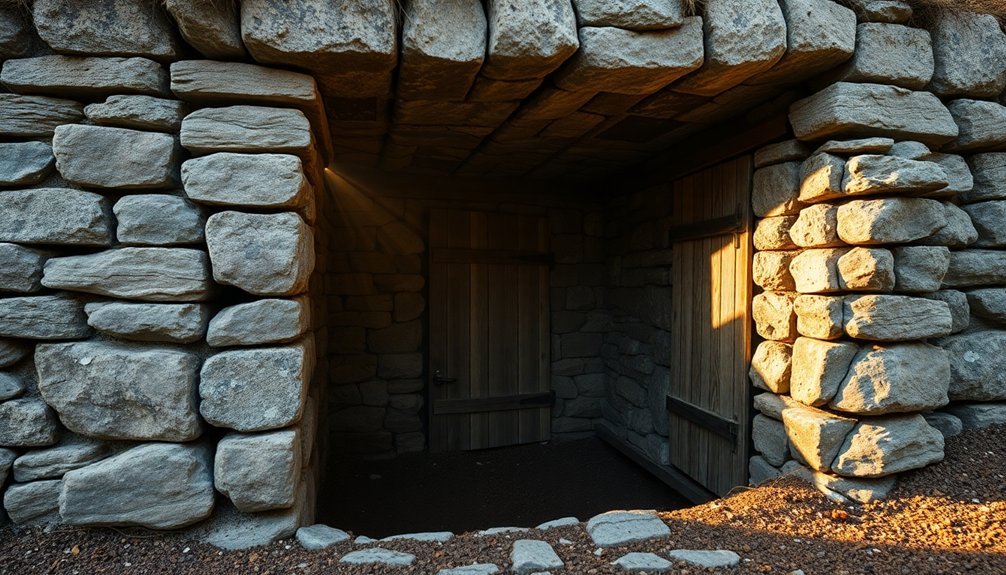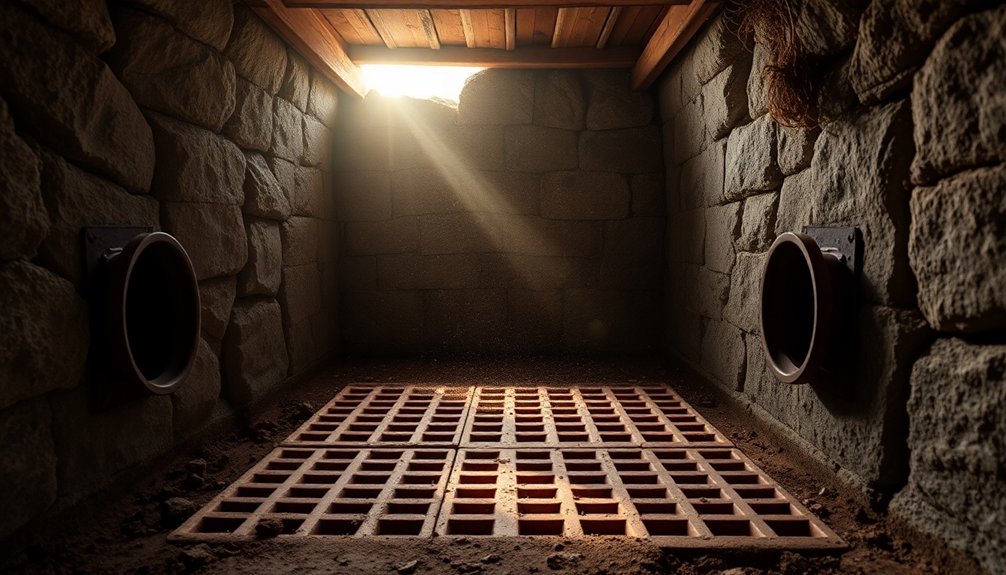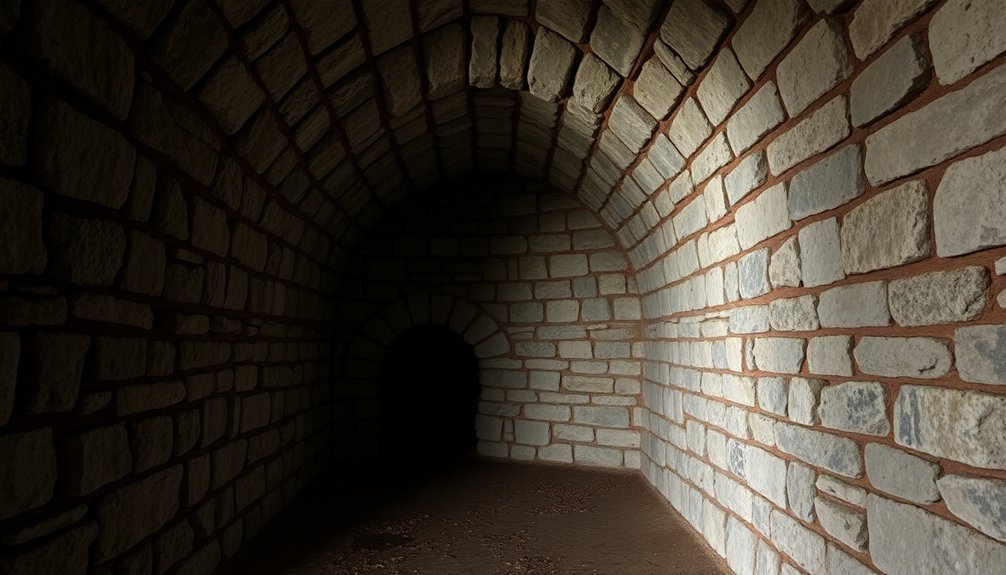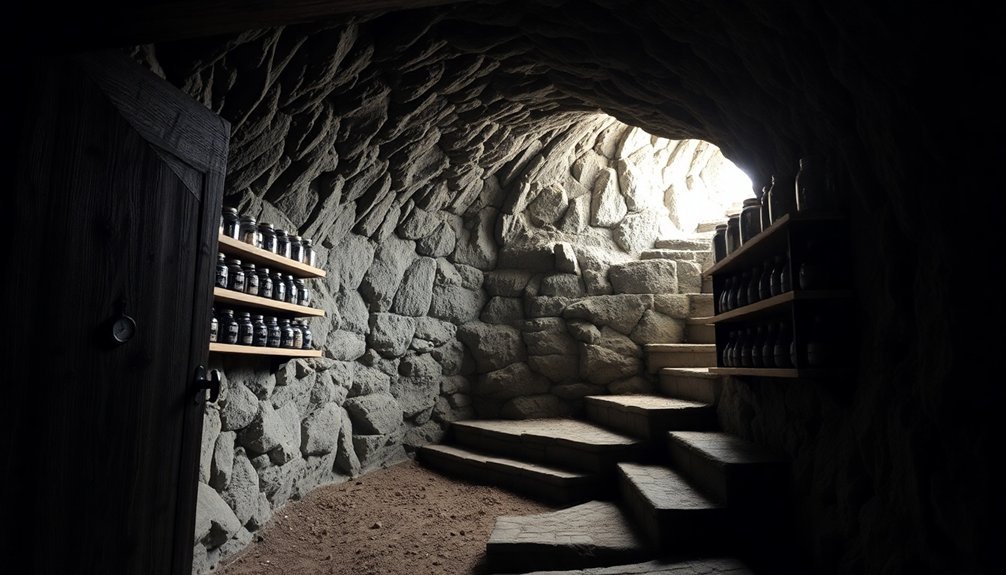Root cellars last for generations when you build them with key fundamentals in mind. You'll want to dig below the frost line (typically 36-48 inches deep) and use durable materials like concrete, stone, or treated wood that resist moisture damage. Proper drainage systems and ventilation prevent water damage and mold growth, while the earth's natural insulation keeps temperatures steady year-round. Your cellar needs carefully positioned intake and exhaust vents to maintain airflow, along with the right humidity levels (90-95%) for food preservation. Understanding these time-tested principles will reveal the secrets of building a root cellar that serves multiple generations.
Building Below The Frost Line

Building down below the frost line is essential for a successful root cellar installation. You'll need to dig deep enough to avoid freezing temperatures, which typically means going below the frost line that ranges from 36 to 48 inches in most locations. For best results, you should aim to construct your cellar approximately 10 feet deep, as this depth provides the ideal temperature stability.
When you're planning your cellar's depth, you'll need to take into account your local climate carefully. If you're in a warmer region, you'll want to dig deeper to reach cooler temperatures that will preserve your stored items. However, if you're building in a colder climate, you'll need to watch out for permafrost, which can cause year-round freezing issues and compromise your cellar's effectiveness. Adding a proper drainage system will prevent water damage and protect your cellar walls from deterioration.
The earth's natural insulating properties work to your advantage at these depths. Since soil conducts heat poorly, it helps maintain consistent temperatures and humidity levels inside your cellar.
You can enhance this natural insulation by adding materials like urethane, Styrofoam, or straw bales, ensuring your root cellar maintains best storage conditions throughout the year.
Natural Temperature Control Systems
You'll find that earth's natural cooling properties create an ideal environment for root cellars, as the soil maintains a steady temperature year-round.
When you build your root cellar below ground level, you're taking advantage of the earth's remarkable ability to stay cool in summer and protect against freezing in winter. Modern root cellars often include temperature monitoring systems to maintain optimal conditions below 5°C.
The seasonal temperature variations become less extreme the deeper you go underground, creating a natural climate control system that's perfect for food storage.
Earth's Natural Cooling Effect
Built upon centuries of traditional wisdom, root cellars harness the earth's remarkable ability to maintain stable temperatures year-round. You'll find that the earth's natural insulation properties keep temperatures consistently between 32-40°F (0-4°C), making it perfect for long-term food storage without external power sources.
When you're planning your root cellar, you'll need to take into account the earth's geothermal cooling principles and natural insulation properties. The ground's thermal mass absorbs and releases heat slowly, creating a stable environment that's vital for preserving your stored foods. Traditional stone and wood materials have proven most effective for construction durability.
To maximize the earth's cooling effect, you'll want to:
- Choose a north-facing slope or shaded location to minimize sun exposure
- Dig below your local frost line to prevent freezing and maintain stable temperatures
- Guarantee proper drainage through strategic soil selection and placement
- Install appropriate ventilation systems to regulate humidity and airflow
You can enhance these natural cooling properties by incorporating proper ventilation systems, whether through solar-powered fans or natural air circulation methods.
The earth's moisture levels also contribute to maintaining the high humidity that's essential for successful food preservation in your root cellar.
Underground Temperature Stability
Throughout the year, a well-designed root cellar maintains remarkably stable temperatures thanks to the earth's natural insulation properties. When you dig just 6 feet underground, you'll find that soil's poor heat conductivity creates a naturally regulated environment that's cool in summer and warm in winter, greatly reducing the need for artificial cooling.
| Temperature Range | Storage Purpose |
|---|---|
| 32°F – 35°F | Long-term storage of most root vegetables |
| 35°F – 40°F | ideal preservation of fruits and hardy vegetables |
| 40°F – 45°F | Short-term storage of semi-hardy produce |
| 45°F – 50°F | Storage of squash and pumpkins |
| 50°F – 52°F | Temperature limit for maintaining quality |
You'll need to maintain humidity levels between 90-95% to prevent your vegetables from shriveling. A dirt floor covered with gravel helps achieve this naturally, and you can sprinkle water on the gravel to boost humidity when needed. Don't forget proper ventilation – it's essential for preventing mold and maintaining healthy produce. Installing an air exchange system with a thermostat will help you draw in cold air when necessary, while an anteroom or double-door system can protect against extreme temperature fluctuations.
Seasonal Heat Exchange Patterns
A well-designed root cellar depends on carefully managed seasonal heat exchange patterns to maintain ideal storage conditions.
You'll need to work with nature's temperature cycles while implementing controls to prevent extreme fluctuations. Your cellar's performance relies on properly managing both active and passive heat exchange systems throughout the year.
To maximize your root cellar's natural temperature control:
- Install adjustable vents with screens to regulate airflow and keep pests out, positioning them strategically for best air circulation.
- Utilize the earth's natural cooling properties by building on north-facing slopes and ensuring your cellar sits below the frost line.
- Add insulation in critical areas, especially near the ceiling and entrance, while incorporating a modest heat source like a 100-watt bulb for extreme cold.
- Create micro-climates within your cellar using sealed containers and perforated storage bins, taking advantage of natural temperature variations near doors and windows.
You'll need to monitor conditions regularly using thermometers and hygrometers, adjusting ventilation and moving stored items as needed.
Remember to inspect your produce frequently and remove any spoiled items to maintain the cellar's integrity.
Proper Drainage And Air Flow

You'll need a well-planned drainage system with crushed rock and perforated pipes to prevent water from pooling around your root cellar's foundation.
When arranging storage inside, keep your shelves spaced apart to allow air movement between stored items and prevent moisture buildup that can lead to spoilage.
Your ventilation shafts should include low-placed intake vents and high-placed exhaust vents to create natural airflow that maintains ideal temperature and humidity levels throughout the storage space.
Prevent Water Pooling Issues
Water pooling can quickly destroy even the best-designed root cellar, making proper drainage and air flow essential for long-term storage success.
You'll need to implement both internal and external water management systems to keep your cellar dry and functional for generations.
Start with external drainage by installing a properly sloped drain pipe that's level with your cellar floor.
Cover it with 18 inches of gravel and protect the exit point with cement and wire mesh to prevent crushing and rodent intrusion.
Don't forget to add rain gutters to your topside structure to direct water away from your cellar walls.
Inside your cellar, you'll want to maintain proper moisture levels without allowing water to pool.
Here's how to achieve this balance:
- Use a gravel or dirt floor instead of concrete to help regulate moisture
- Install plastic sheeting over the gravel floor to prevent ground moisture from seeping up
- Apply waterproof coatings like DryLok to your interior walls
- Set up dual ventilation points at the top and bottom for proper air circulation
Monitor your cellar's conditions regularly with a thermometer and humidistat, adjusting ventilation as needed to maintain ideal storage conditions.
Maintain Airflow Between Shelves
Proper shelf spacing plays an essential role in maintaining ideal storage conditions within your root cellar. You'll need to leave several inches between the shelves and walls to promote air circulation and prevent ethylene gas buildup.
Raise your shelves off the floor to enhance airflow and prevent moisture accumulation that can lead to mold.
When arranging your shelves, ascertain there's adequate space between them for easy access and proper ventilation. Place produce with similar storage requirements together, using higher shelves for items that prefer warmer, drier conditions and lower shelves for those needing cooler, more humid environments.
Your shelves must be sturdy enough to support the weight of stored produce without compromising airflow.
You'll want to maintain humidity levels between 60-95%, depending on your stored items. Use hygrometers to monitor conditions and add moisture by sprinkling water on the floor or using water containers.
Install intake vents near the ground and outlet vents close to the ceiling to create passive airflow. During winter, seal these vents tightly to maintain temperature, and open them at night during summer to release hot air and ethylene gases.
Strategic Ventilation Shaft Placement
A root cellar's ventilation system relies on strategically placed intake and exhaust vents to maintain ideal storage conditions.
You'll need to position these vents on opposite sides of your cellar, with the exhaust vent near the ceiling and intake vent near the floor. This setup takes advantage of natural air movement, as hot air rises and cold air sinks, creating effective circulation throughout your storage space.
To guarantee your ventilation system works effectively, follow these essential steps:
- Install wire racks on your shelves to enhance airflow around stored produce.
- Add a small electric fan in the exhaust vent to boost air circulation when needed.
- Monitor humidity levels using a humidistat, aiming for 60-80% to prevent produce damage.
- Open vents during nighttime hours to capture the coolest air.
You'll want to integrate your ventilation with proper drainage by installing a French drain system around the cellar's exterior.
Use perforated pipes laid in gravel, sloping slightly away from the structure. This combination of airflow and drainage management guarantees your cellar maintains ideal conditions while protecting its structural integrity for generations to come.
Earth Insulation Techniques
Creating effective earth insulation stands as one of the most essential aspects of root cellar construction. You'll want to take advantage of the earth's natural insulating properties by building your cellar at least 4 feet deep, where the ground temperature remains stable throughout the year. This depth helps maintain cooler temperatures in summer and prevents freezing in winter.
You can enhance the earth's natural insulation by incorporating various materials into your design. If you're building from scratch, consider using rigid foam sheets on the exterior walls, combined with insulating blankets between the concrete and surrounding earth.
For a more natural approach, you'll find that straw or hay bales packed into the walls and ceiling provide excellent insulation, though you'll need to replace them periodically and guarantee proper ventilation to prevent mold.
If you're interested in alternative construction methods, earthbag walls offer impressive insulation benefits. You can fill these bags with earth or sand and stack them to create thick, temperature-stable walls.
When combined with concrete's thermal mass properties, you'll create a root cellar that effectively resists temperature fluctuations and stands the test of time.
Essential Construction Materials

Selecting the right construction materials forms the foundation of a successful root cellar project. You'll want to focus on materials that can withstand moisture, temperature variations, and the test of time while maintaining proper humidity levels for food preservation.
- Start with durable structural components like concrete footers and reinforced walls using rebar. These elements prevent shifting and provide essential stability that'll keep your cellar intact for generations.
- Choose moisture-resistant building materials such as stone, concrete, or properly treated wood. When using masonry, remember that uninsulated walls can help conduct cool ground temperatures, enhancing your cellar's natural cooling properties.
- Install thorough moisture management systems, including vapor barriers and waterproofing materials. You'll need plastic sheeting to line the excavation and proper drainage systems to handle surface water runoff.
- Include maintenance-friendly materials like gravel and sand for drainage.
If you're considering alternative options, recycled materials such as earthbags or used tires can provide cost-effective durability when properly implemented.
Dark Environment Design Features
Inside every successful root cellar, darkness plays an essential role in preserving your stored food. You'll need to design your cellar with specific features that block both natural and artificial light to prevent food deterioration, nutrient loss, and premature sprouting.
Start by positioning your root cellar below ground level, preferably on a north-facing slope to minimize sunlight exposure. You'll want to seal the entrance thoroughly and eliminate any gaps or cracks that could let light seep in.
If you've got windows or vents, cover them with light-blocking materials like burlap or proper shades.
When it comes to lighting solutions, don't install permanent fixtures that might accidentally be left on. Instead, rely on portable light sources like headlamps or flashlights for your visits. You'll find this approach more practical and safer for your stored produce.
Choose dark-colored or light-blocking materials for your shelving units to further protect your food items.
Remember to check regularly for any developing light leaks and repair them promptly. Your produce will stay fresher longer when you maintain consistent darkness, as it slows down decomposition and prevents ethylene gas buildup that accelerates spoilage.
Frequently Asked Questions
How Often Should Root Vegetables Be Rotated to Prevent Cross-Contamination?
You'll need to rotate your root vegetables weekly, checking for signs of decay. Don't forget to maintain proper spacing between different types to prevent ethylene gas transfer and potential cross-contamination among stored produce.
Can Multiple Families Share and Maintain a Single Root Cellar Effectively?
Yes, you can share a root cellar effectively with multiple families. You'll need to establish clear schedules for maintenance, organize storage spaces, and work together to monitor conditions and rotate produce regularly.
What Emergency Backup Systems Work Best During Extended Power Outages?
You'll want to invest in a scalable battery system with solar integration. It's reliable, maintenance-free, and can power your entire home. Portable power stations make great supplements for smaller backup needs.
How Do Different Soil Types Affect Root Cellar Performance?
You'll find that sandy soils drain well but insulate poorly, while clay soils retain moisture but can cause drainage issues. The best soil's a balanced loam that provides natural insulation and adequate drainage.
Which Traditional Preservation Methods Complement Root Cellar Storage Effectively?
You'll find canning, smoking, and fermentation work perfectly with root cellaring. While you're storing root vegetables below ground, you can keep your canned goods, smoked meats, and fermented foods in the same cool environment.
In Summary
You'll find that root cellars endure through generations when you've built them with time-tested principles in mind. By digging below the frost line, using natural cooling systems, ensuring proper drainage, maximizing earth insulation, selecting durable materials, and maintaining darkness, you're creating more than just storage – you're building a lasting legacy. These traditional preservation methods will serve your family for decades to come.





Leave a Reply